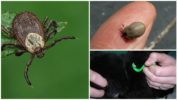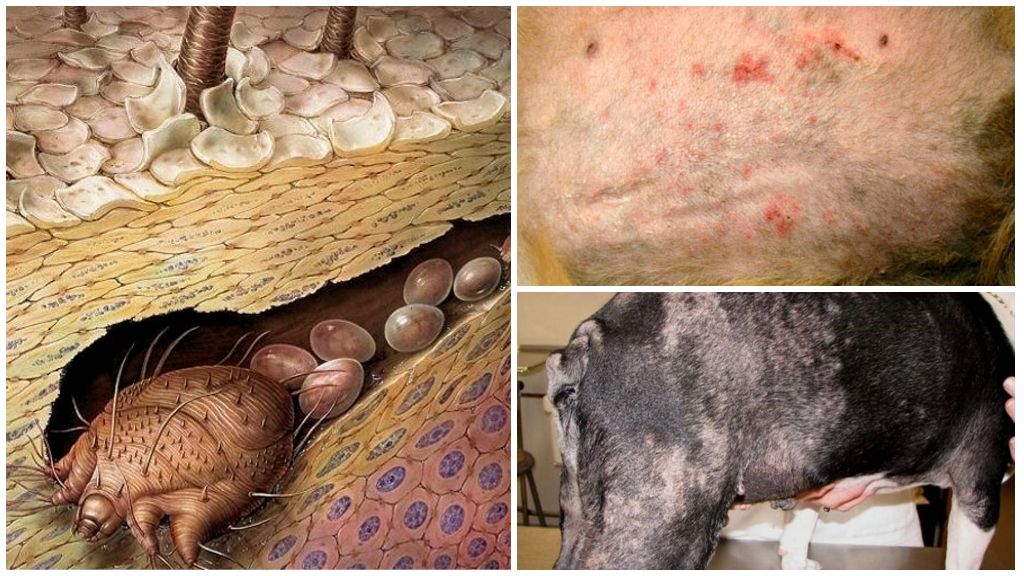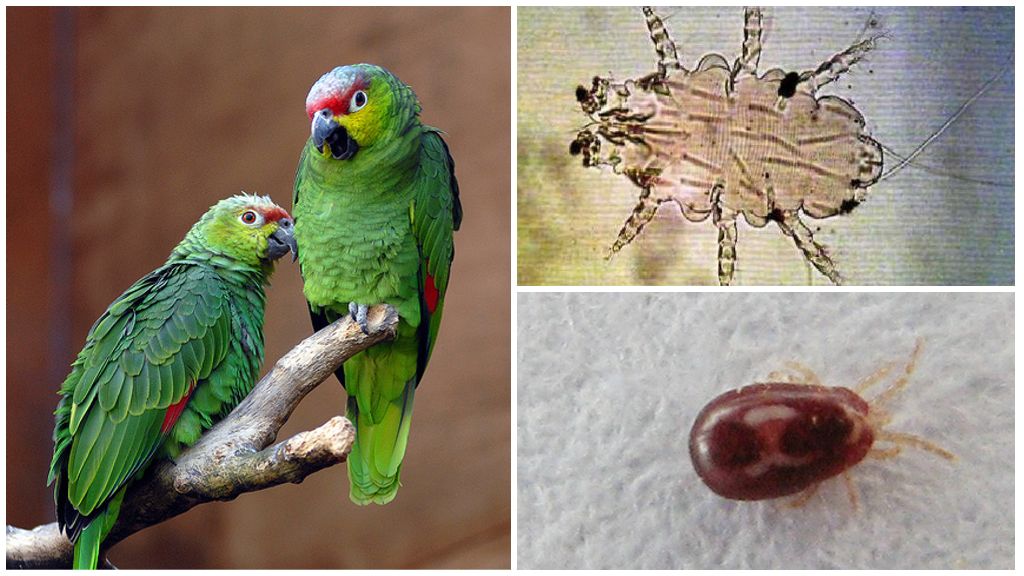- Tick
- Drugs for the treatment of diseases caused by ticks
- Tick Treatment
- Ixodid tick
- Tick
- Tick protection products
Tick-borne infestation is one of the common parasitic diseases in cats. Therefore, each pet owner, when a tick is found in a cat or cat, should know all the nuances: which species it belongs to, methods of removal, symptoms of possible infection and treatment methods.
Description of the parasite and its variants
Ticks (Acari - lat.) Belong to the small arthropod subclass of arachnids. The main diet of their diet: decaying organic matter, vegetable juices and small breeds. Habitat: grass, leaves of shrubs and trees, buds, skin of animals and birds, where they find food in the form of blood, lymph and particles of the epithelium.
Interesting!
Not all pet owners know that mites in cats are not only those that can cling to wool in the forest or on the street, but also subcutaneous, living in the upper layers of the epidermis or in the ear canal. Therefore, it is necessary to talk about all the diversity of species, of which there are more than 1000 in the world.
The most common types of ticks in cats and cats:
- ixodic or forest, which can be carriers of infectious diseasesdangerous for both people and animals;
- subcutaneous or scabiescausing various epidermal diseases;
- ear, settling in the ear canal of a cat or cat.
Tick infection routes
Blood-sucking parasites live on the ground and in the grass, as well as on wild and domestic animals, therefore, a cat can “catch” a tick in various ways:
- while walking on the street, in a park or forest;
- when communicating with a sick animal;
- through infected objects: dishes, rug, etc .;
- from his own master, who can bring the "bloodsucker" to the house on his clothes.
Even domestic cats that have never been on the street can be infected with such parasites. The signs of a tick in a cat are manifested in a change in its behavior and general state of health, so the owner should periodically examine his pet for parasites among the hair, ears and other parts of the body.
Important!
The danger to the animal after the attack of the "bloodsuckers" is that they not only cause trouble, clinging to the skin and sucking blood, but also are often carriers of infections, causing serious illness in pets.
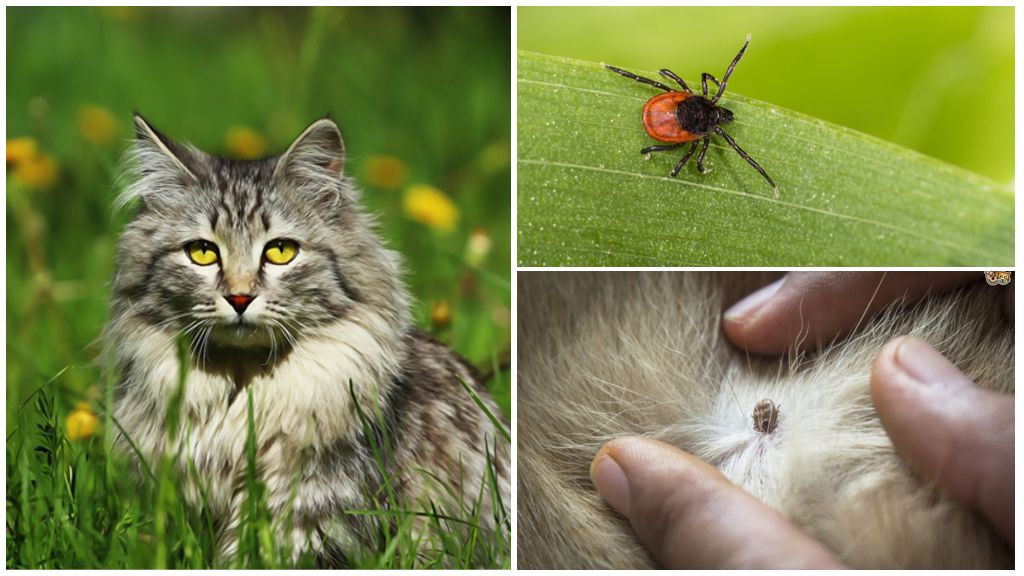
Subcutaneous ticks
Demodexes or hair mites live in small numbers in the upper layers of the skin and follicles at the base of the hair in areas of minimal pubescence: head, paws, neck, and places around the eyes. Parasites feed on dead particles of the epidermis and can exist for many years without causing any harm to the animal.
Initially, demodex was called ciliary or eye tickwho parasitized on livestock, and then switched to pets and humans. This name was given because parasites affect not only the skin, but also settle on the eyelashes near the eyes.
Signs of the disease appear only during a period of decreased immunity in the pet in the form of the following symptoms:
- the animal is nervous due to severe itching, constantly trying to itch;
- on the affected areas, the coat becomes thin, baldness is possible;
- scratches to blood, crusts, vesicles with pus appear on the skin.
Diseases caused by subcutaneous ticks, and their symptoms:
- Demodecosis - It affects the upper layers of the skin, causing constant itching and allergic reactions, degeneration and scars on the surface of the epidermis.
- Cat scabies or notoedrosis - manifested by the formation of sores on the skin and large fistulas that begin in the head area, and then spread down the body, leading to severe itching and baldness. Ring mites can be transmitted to humans and other animals.
- Heyletiellosis (walking dandruff) - looks like copious dandruff with a mass of microscopic ticks, the movement of which gives the impression of stirring (hence the name). Its signs are scaly nodules on the skin of the back, hair loss. The disease is contagious to humans.
- Sarcoptosis or itchy scabies - first appears on the cat's face, then affecting the entire body, is expressed in the formation of scabs and crusts, which is accompanied by intolerable itching. Sarcoptoid ticks in cats are intradermal parasites, infection occurs through objects and in contact with sick animals.
Having determined the presence of subcutaneous ticks by characteristic symptoms, treatment is carried out only after the correct diagnosis and analysis made in a veterinary clinic. Scrapes of the affected epithelium are usually taken, allowing you to accurately determine the type of parasite.
On a note!
Treatment depends on the severity of the manifestation of the disease: lighter forms are often healed by improving the pet’s immunity after proper nutrition and caring.

If the disease is started, then the following procedures are used to cure:
- Baths with keratological shampoos.
- They do a haircut in damaged places, and then they are treated with acaricidal preparations: ointments and drops Fungin (solution cost 150-160 rubles, spray about 300 rubles), Iruxovetin (price 370-400 rubles), Safroderm, Amitrazin.
- Bacterial complications must be treated with a course of antibiotics prescribed by a doctor.
- Vitamin preparations and supplements: Ligfol is a drug for stimulating regenerative processes in animals, improving immunity, and accelerating wound healing (price per 100 ml is about 1800 rubles).
- For the treatment of fungal infections, Ivermectin is administered subcutaneously. The price of the drug and its analogues depends on the volume of liquid for injection and ranges from 200 to 1500 rubles.
- Be sure to carry out the treatment of all animals that have been in contact with the diseased.
- The sick cat's quarantine lasts 30 days.
- Disinfection of the room and care items with the help of disinfection of the room and care items with acaricidal drug (Delta Zone, etc.)
Cat ear mite
Otodecosis or ear scabies is caused by the settlement of Notoedres cati microscopic mites in the cat's ear canal. The main symptoms of the disease: the animal feels discomfort, anxiety, shakes his head and combes his ears.
On a note!
When examining the ear canal, dried brown crusts are visible, which are the product of a large amount of vital activity ear cat tick, as well as a characteristic smell.
With the timely detection of the disease, treatment of ticks in cats at home is as follows:
- Mechanical cleaning and removal of crusts from a pet’s ears using disinfecting solutions: Furacilin, Camphor alcohol, diluted Hydrogen Peroxide.
- Immunomodulating drugs and vitamins.
- Cat instilled into the ear canal healing drops followed by massaging to distribute them over the auricle: Tsipam (price 140-150 rubles), Otoferonol (90-110 rubles).
- Some veterinarians prescribe a one-time injection to the cat from ticks in the form of an injection of the drug Ivermek (the price depends on the packaging of the drug - from 90 rubles), which has an anthelmintic and arachno-entomocidal effect, causing a quick therapeutic effect, for cats, the dosage should be selected based on the weight: 0.1 ml per 5 kg.
- Skin treatment with Wilkinson ointment (price about 40 rubles) on an acaricidal basis.
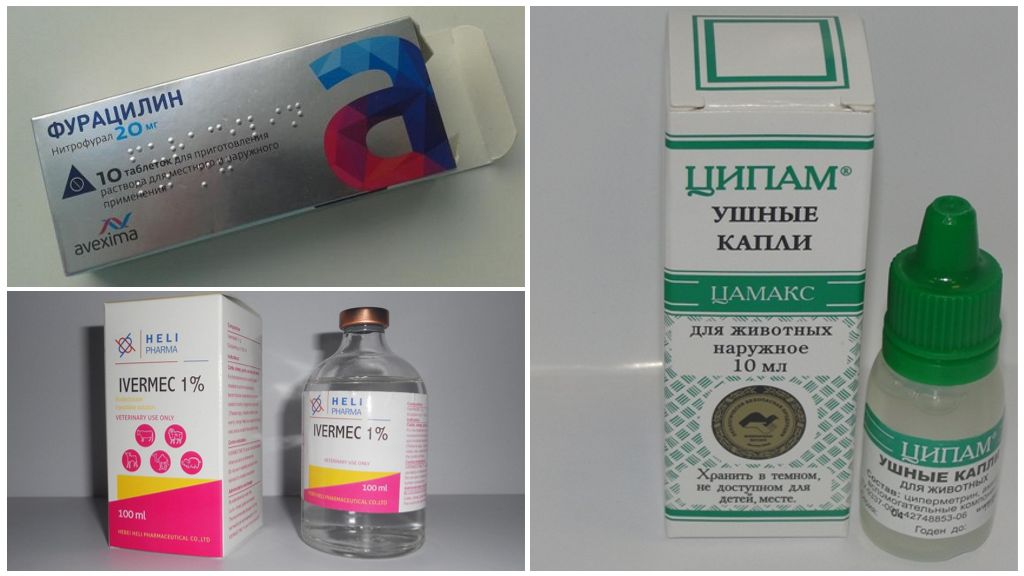
The struggle with the ear tick is usually long and takes about a month, but even with the departure of the main symptoms, the procedure should be continued for another week.
Important!
For the entire treatment period, in order to facilitate grooming and in order to prevent combing of the ears, a special collar should be put on the cat, which will help speed up the healing process.
With a running disease, not only the ear shell and eardrum, but also the meninges can be affected, otitis progresses with purulent discharge, which will have a negative effect on hearing and can cause the death of the animal.
Alternative methods of treating an ear tick in cats are used at the initial stage of the disease in the absence of strong scratching. To clean the ear canals, you can use herbal infusions according to the following recipes:
- tincture of green tea is prepared from 2 tsp. dry leaf mass in a glass of boiling water, after cooling, instill 2-3 drops. in both ears for 30-45 days;
- almond oil - apply after cleansing: drip to do massage of each ear;
- ointment of 3 tbsp. l vegetable oil and ½ clove of garlic is used for daily lubrication of the cat's ear passages, however in rare cases this can cause allergies.
Ixodid tick: how it looks and how to remove
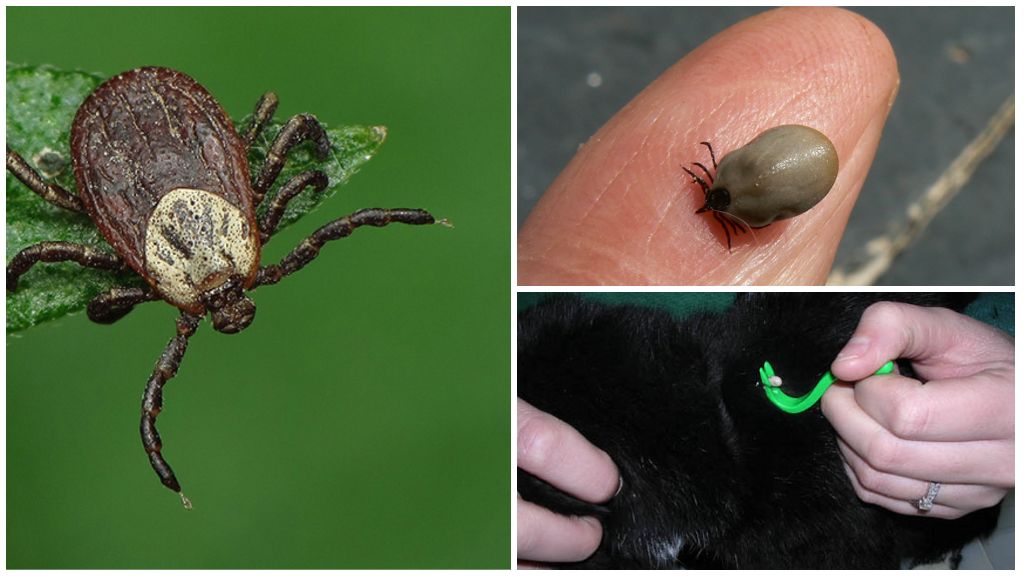
These parasites are the most common in the warm season from spring to early fall. The size of the forest tick is 3-4 mm, outwardly it looks like a small spider of gray-brown color, has a chitinous shell. If it gets on the wool, it does not immediately bite into the skin, and can crawl for 2-3 hours, choosing a suitable place for a “lunch”. Therefore, a hungry gray or white tick can be seen between the hairs when it is in search and try to catch it.
After suction and blood saturation, the parasite increases sharply to 1.5 cm and acquires a red-brown or gray body tint, as seen in the photo of a tick in a cat.
Animals can easily pick up parasites while walking in the park, where there are various plants. Most often, "bloodsuckers" are sucked in places that are not accessible to the cat, which is why it cannot remove them independently: on the neck, stomach, behind the ears, on the withers, groin and armpits.
On a note!
Maximum ixodid tick activity: spring and autumn, it is during this period that they are hungry and evil.
The oral apparatus of the tick contains a proboscis with which it pierces the skin and clings tightly to it, injecting anesthetic saliva. The cat does not feel the moment of bite, and only after several hours, and sometimes days, it can be detected. The longer the parasite drinks blood, the more and the more difficult it is to remove it.
The danger of ixodid tick bites to animals is their ability to carry severe viral infections that penetrate the saliva injected under the skin.
Dangerous infections and possible consequences:
- Pyroplasmosis - causes a decrease in red blood cells in the blood, which leads to intoxication of the body of a sick pet, which manifests itself in fever, lethargy, refusal to eat, without timely treatment, death is possible.
- Hemobartonellosis is a form of infectious anemia that causes a chronic disease of the internal organs.
- Teileriosis or hemosporidiosis - affects the circulatory system, causing hemorrhages, which can lead to blockage of blood vessels and death of the pet.
- Tularemia - leads to lymph damage, intoxication and blood poisoning, death is possible.
- Ticks also spread worm eggs, which enter the body through saliva.
What to do if a cat has a tick

It’s easiest to find a “bloodsucker” among cat's hair when a tick is stuck to the skin and increased in size. Then it must be removed as soon as possible in order to try to avoid infection.
rules extraction of ticks in cats:
- The owner should wear rubber gloves to avoid direct contact, after the procedure, be sure to wash your hands.
- You can not drip oil on the parasite, so as not to accelerate the spread of infection.
- Remove the ixodid tick from the cat as a whole, for which they use special tweezers Tick Twister, which capture the parasite, and then unscrew it by turning clockwise.
- Using a twisted thread may break or damage the tick.
- If the head of the parasite remains under the skin, then the wound must be treated with an antiseptic to avoid infection.
- If you suspect infection: a tick, put in a glass container, you can pass to the laboratory or clinic for analysis for infection.
- To destroy the drained parasite, they put it in a jar of alcohol, rather than crush it, because they are very tenacious, and even after rinsing into the toilet bowl, they can survive, thanks to the "air sac".
What to do after removal
The likelihood of infection of a pet after a tick bite is much lower than in dogs. Symptoms of the onset of cat disease from ticks may appear within 2-3 weeks, so it is necessary to carefully monitor the pet and its condition during the incubation period.
Important!
Particular attention should be paid if ticks have been detected in a kitten, in which a strong negative reaction of the body from unformed immunity is possible.
Negative symptoms include a fever in a cat or cat, apathy, loss of appetite, emaciation, diarrhea or vomiting, cough, shortness of breath, pink urine.
If signs indicating infection appear, you should immediately contact a veterinarian, where, after diagnosis and analysis, the doctor will prescribe the appropriate treatment. Its effectiveness depends on early diagnosis, the severity of the disease, the state of the cat's body, the effectiveness of the drugs.
Prevention and protection of cats from ticks

It is almost impossible to protect completely a pet that regularly walks on the street. Vaccinations against parasites also do not exist, because they do not belong to microbes. The only measure left is the application insect acaricidal preparations for catsthat are added to sprays, drops, collars and shampoos for pets.
Fighting ticks in cats is necessary by various methods, trying to prevent their attack and reduce the risk of bites:
- Put on a special cat collar for ticks and fleaswhich smell repels parasites.
- The safest and most effective way is to use dropsdesigned to kill ticks caught in cat hair. They are sold in ampoules and applied to the skin and protect the cat for 1-3 months: Front lineAdvantix Stronghold and etc.
Although such funds do not provide a 100% guarantee, their use in cats and cats for the period from late spring to early autumn will avoid the attack of "bloodsuckers", which means a possible infection with infectious diseases.



